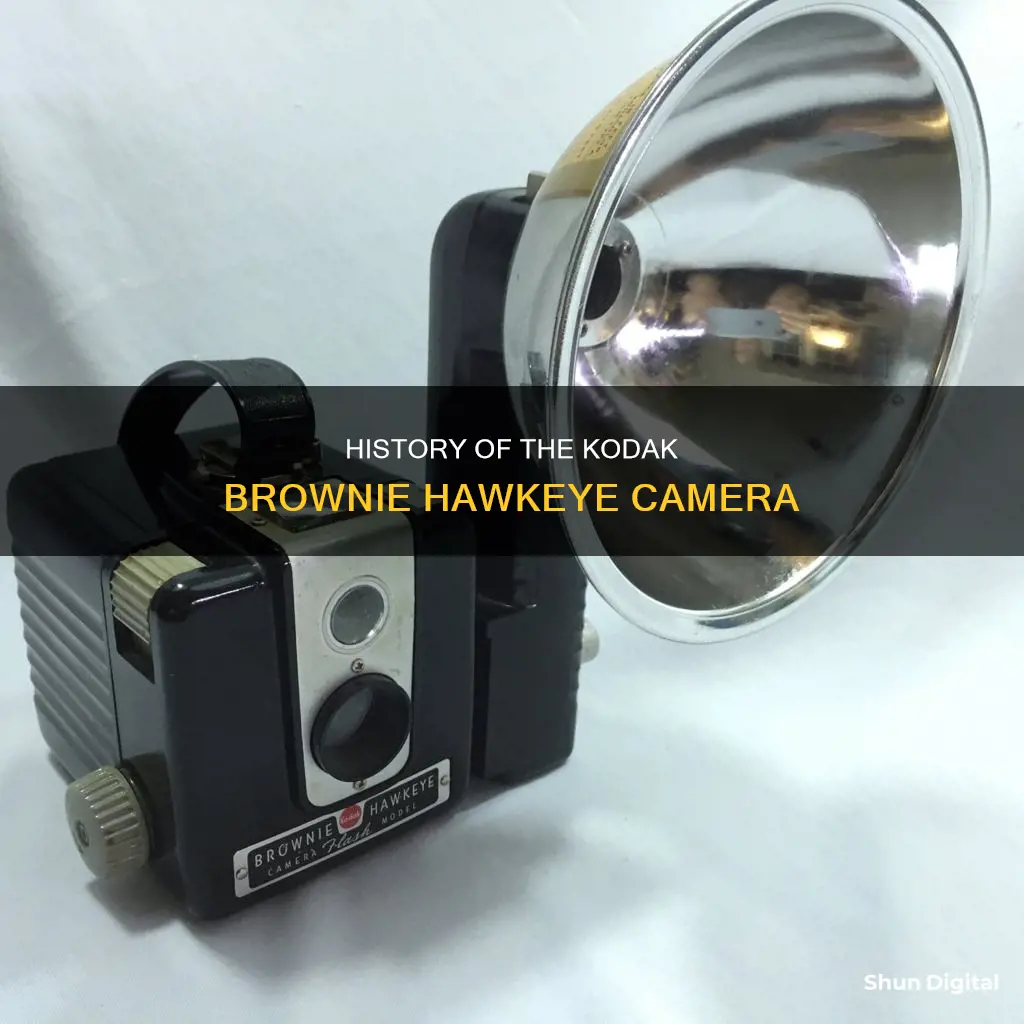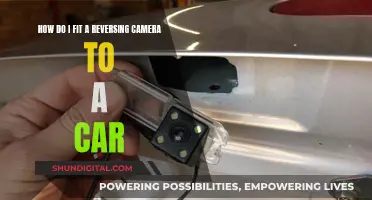
The Kodak Brownie Hawkeye camera was made from 1949 to 1961. It was designed by Arthur Hunt Crapsey Jr. and was one of many easy-to-use cameras made by Kodak for everyday people who wanted to take snapshots of their lives. The Brownie Hawkeye was upgraded in the 1950s and given the added title of Flash Model, allowing it to pair with many of the Kodak pin and screw-type flashes.
| Characteristics | Values |
|---|---|
| Date of Production | 1949-1961 |
| Film Type | 620 Roll (6x6) |
| Lens | Single Element Meniscus |
| Aperture | f/15 |
| Shutter | Rotary, fixed-speed, approximately 1/30th-1/50th |
| Exposure Value at ASA 100 | approximately 13-14 (to infinity in "B" mode) |
| Shutter Speeds | Instant or Bulb |
| Viewfinder | Waist level |
| Cable Release Thread | No |
| Place of Manufacture | USA and France |
| Designer | Arthur H Crapsey |
What You'll Learn

The Kodak Brownie Hawkeye was made from 1949-1961
The Kodak Brownie Hawkeye was in production from 1949 to 1961. It is a Bakelite box camera that takes 12 6x6cm images on 620 film. The camera was made in the USA and France by Kodak. The original design did not include a flash facility, but this was added in 1950, creating the Brownie Flash model in France and the Kodak Brownie Hawkeye Flash in the USA. The camera is compact and box-shaped, with a carrying handle on top and a winding knob to the photographer's right. The design aesthetic is a throwback to the Art Deco era of the 1920s, with clean, minimalist fluting on the sides and an attractively designed front. The Brownie Hawkeye was designed by Arthur H. Crapsey, who also designed other plastic box cameras with similar aesthetics, such as the Kodak Brownie Bull's-Eye and the Kodak Brownie Star series.
The Brownie Hawkeye features a brilliant waist-level viewfinder, which provides a decent preview of the framing. The camera also has a switch that allows for "bulb" exposure, although no tripod socket is provided to steady the camera during long exposure shots. The shutter speed is likely between 1/30th and 1/50th of a second, requiring the photographer to have steady hands or brace the camera. The camera has fixed settings, with film speed being the only exposure parameter that the user can adjust. The lens is believed to focus from 10 feet to infinity, although some claim that it can focus a little closer. The aperture is usually too small for indoor photography, even in well-lit rooms.
The Brownie Hawkeye was one of many easy-to-use cameras made by Kodak for everyday people who wanted to take snapshots of their lives. It was upgraded in the 1950s and given the additional title of Flash Model, allowing it to pair with various Kodak pin and screw-type flashes. The camera is simple to operate, with a shutter button and advance knob on one side and an instant-to-bulb switch on the other.
Shutter Mode Simplified: Easy Steps for Canon Cameras
You may want to see also

It was made in the USA and France
The Kodak Brownie Hawkeye camera was made in the USA and France between 1949 and 1961. The original design, introduced in May 1949, did not have a flash facility. This non-flash model was manufactured until November 1951. In September 1950, the first flash model was introduced, which was capable of accepting a wide range of Kodak pin and screw flash attachments. This model was manufactured until July 1961.
The Kodak Brownie Hawkeye was designed by Arthur H. Crapsey, who also designed other plastic box cameras with similar aesthetics, such as the Kodak Brownie Bull's-Eye and the Kodak Brownie Star series. The camera is compact and box-shaped, with a carrying handle on top and a winding knob to the photographer's right. The design aesthetic is a throwback to the Art Deco era of the 1920s, with clean minimalist fluting on the sides and an attractively designed front.
The Kodak Brownie Hawkeye is a Bakelite box camera that takes 12 6x6cm images on 620 film. The lens is a single element meniscus, with an aperture fixed at f/15. The shutter is rotary and fixed-speed, with speeds of approximately 1/30th-1/50th of a second. The camera also features a "bulb" setting for time exposures. The viewfinder is a waist-level finder, which provides a decent preview of the framing.
The Kodak Brownie Hawkeye was one of many easy-to-use cameras made by Kodak Eastman for everyday people who wanted to take snapshots of their daily lives. It was popular due to its simplicity and low price, and it is still used by film photographers today.
Unleash Photography with Camera Raw CC
You may want to see also

It was designed by Arthur Hunt Crapsey Jr
The Kodak Brownie Hawkeye camera was designed by Arthur Hunt Crapsey Jr. (1919-1998), an influential camera designer working for Eastman Kodak. Crapsey joined Kodak as one of their first industrial designers in 1945 after serving as a pilot in the US Army Air Corps during World War II, where he lost his right leg.
Crapsey had a hand in a great many designs and is acknowledged as the main designer of the Kodak Brownie Star series. He also designed the Instamatic M-6 cine camera in 1965 and was manager of the Eastman Kodak design group in 1960. Between 1948 and 1958, Crapsey was credited with patents for a large number of cameras, including the Kodak Brownie Bull's-Eye, the Kodak Brownie Flash 20, the Kodak Brownie Holiday/Brownie Bullet, the Kodak Brownie Starflex, the Kodak Brownie Starlet, and the Kodak Brownie Starmatic (with Mary Eaton).
The Kodak Brownie Hawkeye was produced from 1949 to 1961 and was made of Bakelite. It was designed to be easy to use, with a shutter button and advance knob on one side and a switch for instant to bulb on the other. It was one of many cameras that Kodak Eastman made for everyday people who wanted to take snapshots of their daily lives.
The camera has a brilliant waist-level viewfinder and takes 12 6x6 shots on 620 film. The lens, which is around 80mm, focuses from 5 feet to infinity according to the manual, but it is believed that it is actually 10 feet or more. The shutter speed is around 1/30th of a second, with an aperture of around f/15, which means the photographer must hold the camera very steady while taking a shot.
The Brownie Hawkeye was upgraded in the 1950s and given the added title of Flash Model, which could pair with many of the Kodak pin and screw-type flashes.
Understanding Raw File Support in Modern Cameras
You may want to see also

It was made of Bakelite
The Kodak Brownie Hawkeye camera was made of Bakelite, a hard plastic material that was popular in the Art Deco era of the 1920s. The camera's body is moulded from this material, giving it a sleek and compact design. The choice of Bakelite for the Brownie Hawkeye is notable as it contributes to the camera's robust and durable nature.
Bakelite was a revolutionary material when the camera was first introduced in 1949. It offered advantages in terms of strength and impact resistance compared to other materials used in camera construction at the time. This made the Brownie Hawkeye a reliable option for photographers, especially those who enjoyed outdoor photography and needed a sturdy camera to withstand varying conditions.
The use of Bakelite also allowed for intricate details and a streamlined shape. The Brownie Hawkeye's design, created by Arthur H. Crapsey, showcases the beauty of Bakelite with its smooth, curved edges and minimalist fluting on the sides. The material's ability to be moulded into complex shapes contributed to the camera's aesthetic appeal.
One of the unique characteristics of Bakelite is its ability to retain its shape and durability over time. Vintage Kodak Brownie Hawkeye cameras that are still in existence today often maintain their structural integrity due to the lasting properties of Bakelite. This has contributed to the camera's longevity and its presence in antique stores and collections.
The decision to use Bakelite for the Kodak Brownie Hawkeye was a significant factor in its popularity and success. The material's combination of strength, design flexibility, and longevity made it a practical and attractive choice for photographers, ensuring the camera's place in the history of photography.
Portrait Mode: Which Cameras Have This Feature?
You may want to see also

It was upgraded in the 1950s to include a flash
The Kodak Brownie Hawkeye was produced between 1949 and 1961. The original design did not include a flash, but this feature was added in 1950 with the release of the Brownie Hawkeye Flash model. This new model was capable of accepting a wide range of Kodak pin and screw flash attachments. The Brownie Hawkeye Flash was manufactured in the USA and sold for $7.00. In France, the same camera was manufactured under the name Brownie Flash.
The Brownie Hawkeye Flash was an upgraded version of the original Brownie Hawkeye, which was released in May 1949. The original model did not have a flash and was discontinued in November 1951. The Flash model was released in September 1950 and remained in production until July 1961.
The addition of a flash to the Brownie Hawkeye was a significant upgrade, as it allowed photographers to use the camera in low-light conditions. The flash also enabled more creative photography, such as using the flash to freeze motion or create dramatic lighting effects.
The Brownie Hawkeye Flash used 620 film and could take 12 6x6cm images. The camera had a single element meniscus lens with a fixed aperture of f/15. The shutter speed was approximately 1/30th to 1/50th of a second, which was relatively slow even for its time. This meant that photographers had to have steady hands or brace the camera to avoid blurry images.
The Brownie Hawkeye Flash had a simple design, with a shutter button and advance knob on one side and a switch for instant or bulb mode on the other. It did not have a tripod socket or lugs for a strap, but it did have a carrying handle on top. The camera was made of Bakelite, a type of plastic that was commonly used in the 1950s.
The Brownie Hawkeye Flash was designed by Arthur Hunt Crapsey Jr., who also designed many other popular Kodak cameras. It was one of many easy-to-use cameras that Kodak Eastman made for everyday people who wanted to take snapshots of their daily lives. The camera was compact and box-shaped, with a winding knob on the right side.
Charging Camera Batteries: Empire Adapter Instructions
You may want to see also
Frequently asked questions
The Kodak Brownie Hawkeye camera was made from 1949 to 1961.
The camera is made of Bakelite.
The camera was designed by Arthur Hunt Crapsey Jr., who was a designer for Kodak.
The camera uses 620 film and takes 12 6x6 shots.







